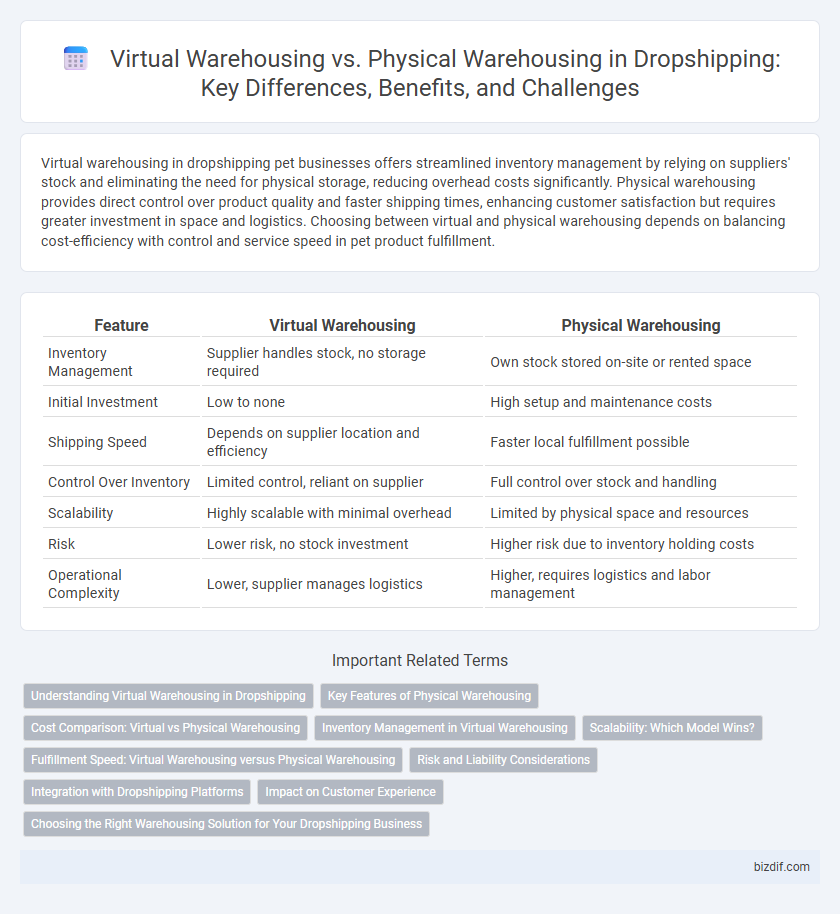Virtual warehousing in dropshipping pet businesses offers streamlined inventory management by relying on suppliers' stock and eliminating the need for physical storage, reducing overhead costs significantly. Physical warehousing provides direct control over product quality and faster shipping times, enhancing customer satisfaction but requires greater investment in space and logistics. Choosing between virtual and physical warehousing depends on balancing cost-efficiency with control and service speed in pet product fulfillment.
Table of Comparison
| Feature | Virtual Warehousing | Physical Warehousing |
|---|---|---|
| Inventory Management | Supplier handles stock, no storage required | Own stock stored on-site or rented space |
| Initial Investment | Low to none | High setup and maintenance costs |
| Shipping Speed | Depends on supplier location and efficiency | Faster local fulfillment possible |
| Control Over Inventory | Limited control, reliant on supplier | Full control over stock and handling |
| Scalability | Highly scalable with minimal overhead | Limited by physical space and resources |
| Risk | Lower risk, no stock investment | Higher risk due to inventory holding costs |
| Operational Complexity | Lower, supplier manages logistics | Higher, requires logistics and labor management |
Understanding Virtual Warehousing in Dropshipping
Virtual warehousing in dropshipping allows sellers to manage inventory and streamline order fulfillment without holding physical stock, leveraging supplier warehouses to ship products directly to customers. This model reduces overhead costs, minimizes storage risks, and enhances flexibility by enabling access to multiple supplier inventories simultaneously. Effective use of virtual warehousing technology integrates real-time inventory data and order tracking, optimizing supply chain efficiency and customer satisfaction.
Key Features of Physical Warehousing
Physical warehousing offers tangible storage space for inventory, enabling direct control over stock management and quality inspection. It supports bulk storage with advanced shelving systems, real-time inventory tracking, and facilitates efficient order fulfillment through on-site packing and shipping. This method reduces dependency on third-party logistics, allowing businesses to optimize handling processes and minimize shipping errors.
Cost Comparison: Virtual vs Physical Warehousing
Virtual warehousing significantly reduces overhead costs by eliminating expenses related to physical storage space, utilities, and on-site staff, making it more cost-effective for dropshipping businesses. Physical warehousing involves substantial investment in rent, inventory management, and labor, which increases operational costs and capital requirements. Dropshippers benefit from virtual warehouses by paying only for storage and fulfillment services used, enhancing cash flow and reducing financial risk.
Inventory Management in Virtual Warehousing
Virtual warehousing enhances inventory management by utilizing real-time data synchronization across multiple suppliers, reducing the need for holding large stock and minimizing storage costs. Inventory visibility is improved through integrated software solutions, allowing dropshippers to track product availability dynamically and prevent overselling. This system streamlines order fulfillment by automatically routing requests to the nearest or best-performing supplier, ensuring faster delivery and optimized stock distribution.
Scalability: Which Model Wins?
Virtual warehousing offers superior scalability by eliminating physical space constraints and enabling businesses to quickly adjust inventory levels across multiple suppliers and regions. Physical warehousing requires significant investment in storage facilities and labor, limiting rapid expansion and adapting to fluctuating demand. For dropshipping, virtual warehousing wins as it supports flexible growth and reduces overhead costs.
Fulfillment Speed: Virtual Warehousing versus Physical Warehousing
Virtual warehousing leverages multiple distributed suppliers and warehouses, enabling faster order fulfillment by reducing shipping distance to customers. Physical warehousing centralizes inventory, which may lead to longer delivery times due to single-location processing and shipping. Dropshipping utilizing virtual warehousing benefits from optimized fulfillment speed through proximity and network scalability compared to traditional physical warehousing models.
Risk and Liability Considerations
Virtual warehousing reduces risk and liability by eliminating the need for physical inventory storage, thus minimizing potential damage, theft, or loss associated with traditional warehouses. Physical warehousing entails higher liability risks such as property damage, inventory shrinkage, and compliance with safety regulations, requiring insurance and strict security measures. Dropshipping businesses benefit from virtual warehousing by transferring inventory risks to suppliers, reducing financial exposure and operational liabilities.
Integration with Dropshipping Platforms
Virtual warehousing seamlessly integrates with dropshipping platforms by providing real-time inventory updates and automated order processing, eliminating the need for physical stock management. Physical warehousing requires manual synchronization with dropshipping systems, often leading to delays and inventory discrepancies. Efficient API connections in virtual warehousing enhance scalability and order accuracy, crucial for dropshipping business success.
Impact on Customer Experience
Virtual warehousing enhances customer experience by enabling faster order processing and broader product availability without the constraints of physical storage, reducing delivery times significantly. Physical warehousing offers direct inventory control, often resulting in more accurate stock levels and immediate shipping capabilities, which can improve reliability and trust. Balancing both strategies allows businesses to optimize fulfillment speed and accuracy, directly influencing customer satisfaction and loyalty in the dropshipping model.
Choosing the Right Warehousing Solution for Your Dropshipping Business
Choosing the right warehousing solution for your dropshipping business depends on order volume, product type, and customer location. Virtual warehousing offers flexible inventory management by leveraging third-party fulfillment centers, reducing overhead costs and enabling faster delivery times. Physical warehousing provides direct control over stock and packaging, ideal for businesses with consistent high volumes and specialized product handling requirements.
Virtual Warehousing vs Physical Warehousing Infographic

 bizdif.com
bizdif.com